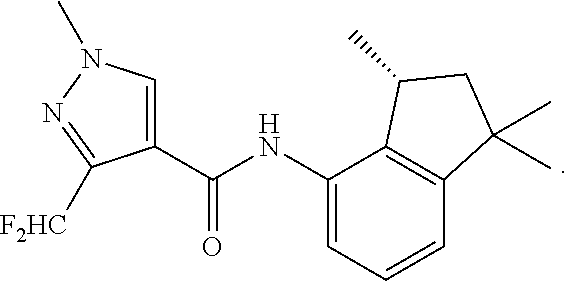Methods for apple scab control
- Summary
- Abstract
- Description
- Claims
- Application Information
AI Technical Summary
Benefits of technology
Problems solved by technology
Method used
Image
Examples
examples
[0043]A 40% suspension concentrate formulation was used as the source of 3-(difluoromethyl)-1-methyl-N-[(3R)-1,1,3-trimethyl-2,3-dihydroinden-4-yl]pyrazole-4-carboxamide (available from Sumitomo Chemical Company, Tokyo, Japan).
[0044]Tourney® fungicide (Tourney® is available from Valent U.S.A. Corporation, Tourney is a registered trademark of Valent U.S.A. Corporation) was used as the source of metconazole.
[0045]Tilt® fungicide (Tilt® is available from Syngenta Corporation, Tilt is a registered trademark of Syngenta Corporation) was used as the source of propiconazole.
[0046]Pentra-Bark® surfactant (Pentra-Bark® surfactant is available from AgBio, Inc., Pentra-Bark is a registered trademark of Quest Products Corporation) was used as the source of surfactant in the following examples. Pentra-Bark® surfactant is a mixture of alkylphenol ethoxylate, polysiloxane polyether copolymers, and propylene glycol.
[0047]Applicant conducted the following study to determine the effect of a 3-(difluo...
example 2
[0049]In this study, the 3-(difluoromethyl)-1-methyl-N-[(3R)-1,1,3-trimethyl-2,3-dihydroinden-4-yl]pyrazole-4-carboxamide treatment was applied at the time of bud swell in mid March on apple tree trunks (treatment 5). The result of this treatment was compared to metconazole treatments applied when the apple trees were dormant (treatments 2 and 3), at the time of bud swell (treatment 4), and a foliar spray applied after petal fall (treatment 6). The control treatment (treatment 1) was applied during bud swell, as well. Four trees were subjected to each treatment.
TABLE 3Rate (gramsactive / cm trunkLeaf pestLeaf pestFruit pestFruit pestFruit pestFruit pestTreatmentdiameter)Phytotoxicityincidenceseverityincidenceseverityincidenceseverity1Control2.3%04.75010.837.502.546.673.0SurfactantV / V2Metconazole +1.72 + 2.3%01.8755.033.752.2545.03.0SurfactantV / V3Metconazole +1.72 + 2.3%01.0001.76.670.33310.00.5SurfactantV / V4Metconazole +1.72 + 2.3%00.1402.014.001.12518.671.5SurfactantV / V53-(difluorome...
PUM
 Login to View More
Login to View More Abstract
Description
Claims
Application Information
 Login to View More
Login to View More - R&D
- Intellectual Property
- Life Sciences
- Materials
- Tech Scout
- Unparalleled Data Quality
- Higher Quality Content
- 60% Fewer Hallucinations
Browse by: Latest US Patents, China's latest patents, Technical Efficacy Thesaurus, Application Domain, Technology Topic, Popular Technical Reports.
© 2025 PatSnap. All rights reserved.Legal|Privacy policy|Modern Slavery Act Transparency Statement|Sitemap|About US| Contact US: help@patsnap.com

